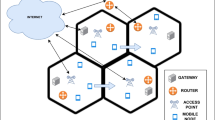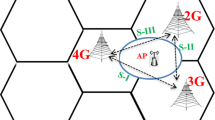Abstract
The Probability Distribution of Slot Selection (PDoSS) of IEEE 802.11 DCF is extremely uneven, which makes the packet collision probability very high. In this paper, the authors explore how to make the stations select the slots uniformly, and give an RWBO(p d , w) algorithm for 802.11 DCF to make the PDoSS even and decrease the packet collision probability. A Markov model is given to analyze the PDoSS of RWBO(p d , w). The performance of RWBO(p d , w) is evaluated by simulation in terms of saturation throughput and packet collision probability. The simulation results indicate that RWBO(p d , w) can decrease the packet contention probability to a large extent, and utilize the channel more efficiently as compared to the 802.11 DCF. Moreover, the relation between saturation throughput and walking probability (p d ), the relation between saturation throughput and contention windows (w), the relation between packet collision probability and walking probability (p d ), and the relation between packet collision probability and contention windows (w) are analyzed. The analysis indicates that RWBO(p d , w) has some remarkable features: its saturation throughout keeps high and packet collision probability keeps very low (under 0.1) in a large range of p d and w, which allow users to configure p d and w more flexibly.
Similar content being viewed by others
References
IEEE standard for wireless LAN medium access control (MAC) and physical layer (PHY) specifications, 1999 Edition.
Bianchi G. IEEE 802.11 — Saturation throughput analysis. IEEE Communication Letters, 1998, 2(12): 318–320.
Binachi G. Performance analysis of the IEEE 802.11 distributed coordination function. IEEE Journal on Selected Areas in Commu., 2000, 18(3): 535–547.
Haitao Wu, Yong Peng, Keping Long et al. Performance of reliable transport protocol over IEEE 802.11 wireless LAN: Analysis and enhancement. In Proc. 21st Annual Joint Conference of the IEEE Computer and Communications Societies, 2002, 2: 599–607.
Ye Fengji, Yi Su, Sikdar B. Improving spatial reuse of IEEE 802.11 based ad hoc networks. In IEEE GLOBECOM’03, San Francisco, USA, Dec. 2003, 2: 1013–1017.
Wang Y, Bensaou B. Achieving fairness in IEEE 802.11 DFWMAC with variable packet lengths. In IEEE GLOBECOM’01, San Antonio, TX, USA, Nov. 2001, 6: 3588–3593.
Thyagarajan Nandagopal, Tae-Eun Kim, Xia Gao, Vaduvur Bharghavan. Achieving MAC layer fairness in wireless packet networks. In Proc. ACM MobiCom’00, Boston, MA, Aug. 2000, pp.87–98.
Shugong Xu, Tarek Saadawi. Does the IEEE 802.11 MAC protocol work well in multihop wireless ad hoc networks? IEEE Communications Magazine, 2001, 39(6): 130–137.
Mangold S, Choi S, May P et al. IEEE 802.11e wireless LAN for quality of service (invited paper). In Proc. the European Wireless, Florence, Italy, February 2002, 1: 32–39.
Jie Hui, Devetsikiotis M. Designing improved MAC packet schedulers for 802.11e WLAN. In IEEE GLOBECOM’03, San Francisco, USA, Dec. 2003, 1: 184–189.
Yong Peng, Shi-Duan Cheng. Performance enhancement and bandwidth guarantee in IEEE 802.11 wireless LANs. Journal of Computer Science & Technology, 2004, 19(2): 150–157.
Li Yun, Long Ke-Ping, Wu Shi-Qi, Chen Qian-Bin. Performance analysis and improvement of IEEE 802.11 DCF. Acta Electronica Sinica, 2003, 31(10): 1446–1451.
Li Yun, Long Ke-Ping, Wu Shi-Qi, Zhao Wei-Liang. A novel self-adaptive algorithm to adjust the minimum contention windows for maximizing the saturated throughput of 802.11 DCF. Submitted to Chinese Journal of Computers.
The networks simulator ns-2. http://www.isi.edu/nsnam/
Author information
Authors and Affiliations
Corresponding author
Additional information
Supported by the National High Technology Development 863 Program of China under Grant No.2003AA121540; the National Natural Science Foundation of China (Grant No.90304004); the Science and Technology Research Project of Chongqing Municipal Education Commission of China under Grant No.050310; the research grants by the Ministry of Personnel of China; the research grants by the Science & Tech. Commission of Chongqing.
Rights and permissions
About this article
Cite this article
Li, Y., Long, KP., Zhao, WL. et al. RWBO(p d w): A Novel Backoff Algorithm for IEEE 802.11 DCF. J Comput Sci Technol 20, 276–281 (2005). https://doi.org/10.1007/s11390-005-0276-x
Received:
Revised:
Issue Date:
DOI: https://doi.org/10.1007/s11390-005-0276-x




